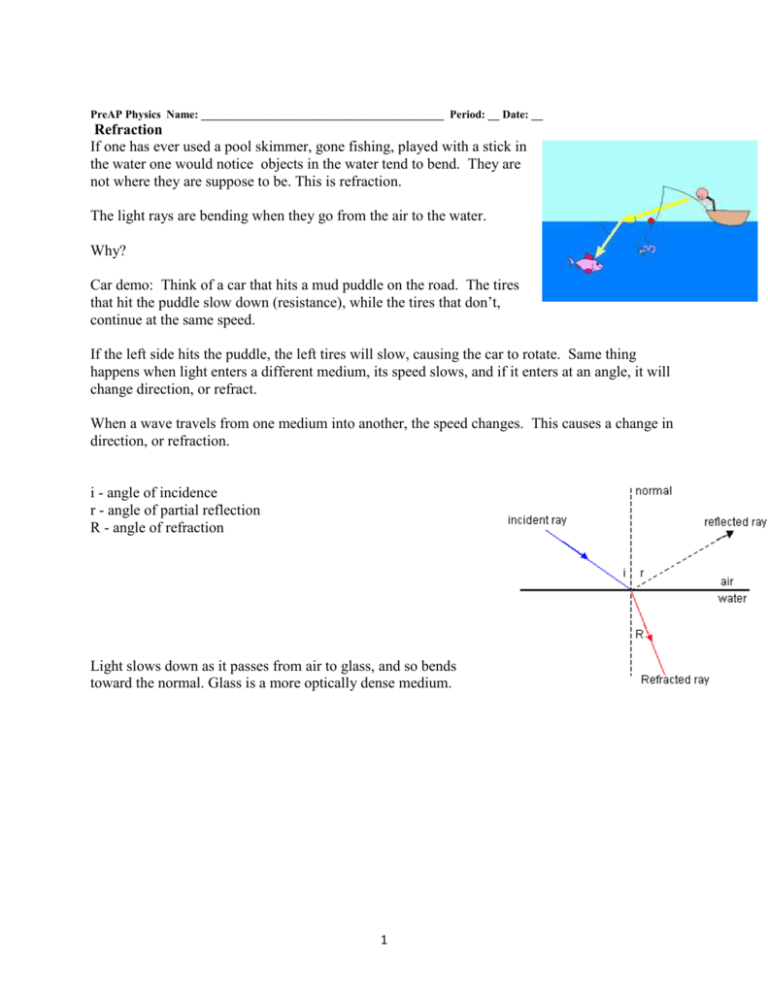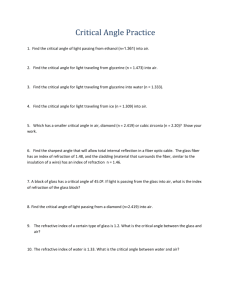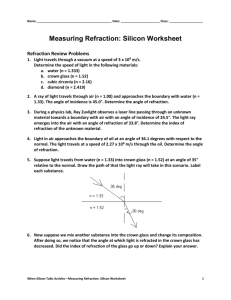Total internal reflection & Critical angle
advertisement

PreAP Physics Name: ___________________________________________ Period: __ Date: __ Refraction If one has ever used a pool skimmer, gone fishing, played with a stick in the water one would notice objects in the water tend to bend. They are not where they are suppose to be. This is refraction. The light rays are bending when they go from the air to the water. Why? Car demo: Think of a car that hits a mud puddle on the road. The tires that hit the puddle slow down (resistance), while the tires that don’t, continue at the same speed. If the left side hits the puddle, the left tires will slow, causing the car to rotate. Same thing happens when light enters a different medium, its speed slows, and if it enters at an angle, it will change direction, or refract. When a wave travels from one medium into another, the speed changes. This causes a change in direction, or refraction. i - angle of incidence r - angle of partial reflection R - angle of refraction Light slows down as it passes from air to glass, and so bends toward the normal. Glass is a more optically dense medium. 1 Light speeds up as it passes from glass to air, and so bends away from the normal. When light passes from one medium to another at 0°, or directly along the normal, no refraction occurs. The relationship between these quantities, the change in speed, and angle is expressed in SNELL’S LAW Snell studied refraction angles and different materials and came up with this relationship: Snell’s Law states: sin i / sin r = v1 / v2 = n2 / n1 Usually it is solved as: n1 sin θ1 = n2 sin θ 2 Remember, the angles are always measured from the NORMAL line. Where n is the index of refraction. Every material has a different index of refraction. Substance Air (vacuum) Water Alcohol Quartz Lucite Benzene Glass – Crown Plexiglas Glass – Flint Diamond Index of Refraction 1.00 1.33 1.36 1.46 1.50 1.50 1.52 1.55 1.61 2.42 The absolute index of refraction is the n of a material when light travels from a vacuum into it. n for a vacuum is 1.00 So, the absolute index of refraction is defined as: n2/n1 = v1/v2 = c/v if n1 = 1, we get n2 = v1/v2 or… ..........: where c is the speed of light in a vacuum ............v is the speed of light in the medium ............n is the index of refraction 2 The speed of light in a vacuum is 3.00 x 108 m/s. The greater the value of n, the slower the speed of light in that medium. Total internal reflection & Critical angle Critical Angle & Total Internal Reflection When light travels into a more optically dense medium at a very special incident angle, the resulting refracted angle is 90°. It follows the surface. This special angle of incidence is called the critical angle of that medium. How to find the critical angle: n1sin c n2 sin 2 theta2 is 90 degrees, so… n1sin c n2 Therefore, sin c n2 n1 Substances that have a high index of refraction (n) have a low critical angle. Diamond has an index of refraction of 2.42 with a critical angle of 24.5°, while water has an index of refraction of 1.33 and a critical angle of 49°. Total Internal Reflection When light passes into a more optically dense medium with the angle of incidence greater than the critical angle, the light simply reflects off the surface. It does not pass through and refract. We call this total internal reflection. Critical Angle Example Problem: 3 What is the critical angle of crown glass (n = 1.52) if light passes from crown glass into air? (Remember that critical angle is always a unique incident angle.) Examples of refraction and critical angles: SUNSETS Light from the setting sun passes from the vacuum of outer space into the air around the Earth. Light starts to bend toward the Earth. The air gets denser closer to the Earth resulting in even more light refraction toward the Earth. To observer X, the sun appears higher, not set. This is because our brain assumes that light always travels in straight lines and if observer X sees the sun, they believe it cannot be set. The brain has been fooled, because in this case light bent, and did not travel in a straight line. Astronomers viewing stars near the horizon must be aware that as the light refracts, the location of the star tends to be inaccurate. Most of the large telescopes on Earth are on mountain tops to reduce atmospheric refraction. The Hubble telescope is in the best place - space. Mirrages: Have you ever driven along a highway in the summer and seen a puddle of water on the road, but it always kept moving? This is a mirage caused by the sun heating the road. 4 The hot pavement heats the air just above it. The light from the sky refracts as it passes into the warm air above the pavement (upper ray in diagram above). The angle of incidence of the incoming rays of light gets larger (bottom ray in diagram above). At some point the angle of incidence gets larger than the critical angle of the hot air above the pavement. Total internal reflection results and you actually see light from the sky. It only looks like it reflects from the road. Because water reflects light and pavement doesn’t, your brain thinks that there must be water on the road to reflect the light from the sky. Your brain is fooled by the bending light. Sparkling Diamonds .......... Why do diamonds sparkle and shine so much? When light strikes the top surface of a diamond, some light is reflected and some passes into the diamond and is refracted. Diamond has a high index of refraction, which means it has a low critical angle (24.5°). If light enters the diamond and hits the bottom or sides at angles greater than 24.5°, it is totally internally reflected. The light rays bounce around inside the diamond and eventually leave out the top or top sides. Even the light that hits the sides or bottom at an angle less than the critical angle will be partially reflected. The diamond must be cut very accurately so that the bottom and sides are at angles that allow for total internal reflection. 5 Fiber Optics Glass has a critical angle of about 43°. The light ray enters the glass fibre and strikes the inside surface at an angle (i) greater than the critical angle (43°). The result is total internal reflection and so the light bounces off the surface and keeps traveling through the glass fibre. This allows the glass fibre to be bent so light can travel around corners. Many glass fibres are combined to make a cable, which can carry thousands of rays of light. The glass fibre is usually coated with a plastic cladding (that has a very low index of refraction) and a protective covering. The light rays transmit telephone, radio, and television signals. Fibre optics is also used in medicine to allow scopes to see inside organs, blood vessels, etc. in minute detail. Dispersion of light The index of refraction in transparent materials such as glass decreases as the wavelength increase, somewhat as shown in the figure. This means that the short wavelengths bend more at a surface between two transparent materials than the long wavelengths. Thus, white light, which consists of a mix of wavelengths, will be dispersed into its component colors when it bends. Since violet has a shorter wavelength than red, then it will be bent more than the red. If white light is passed through a prism, then it is bent going in and coming out. 6 n violet red R V white R V white Rainbows Rainbows are caused by the dispersion of white light by water droplets in the sky. Most rainbows are produced as shown in the diagram to the left. The red part of the rainbow comes from the steeper rays and is at the top. In some cases a secondary rainbow can be seen above the primary rainbow with the colors reversed. Note that the primary rainbow if formed by one reflection from the back of the droplets, while the secondary rainbow undergoes two reflections in the droplet. A nice applet that explains rainbows can be found at http://www.phy.ntnu.edu.tw/ntnujava/index.php?topic=44 Primary Rainbow Secondary Rainbow white white R V V R 7









